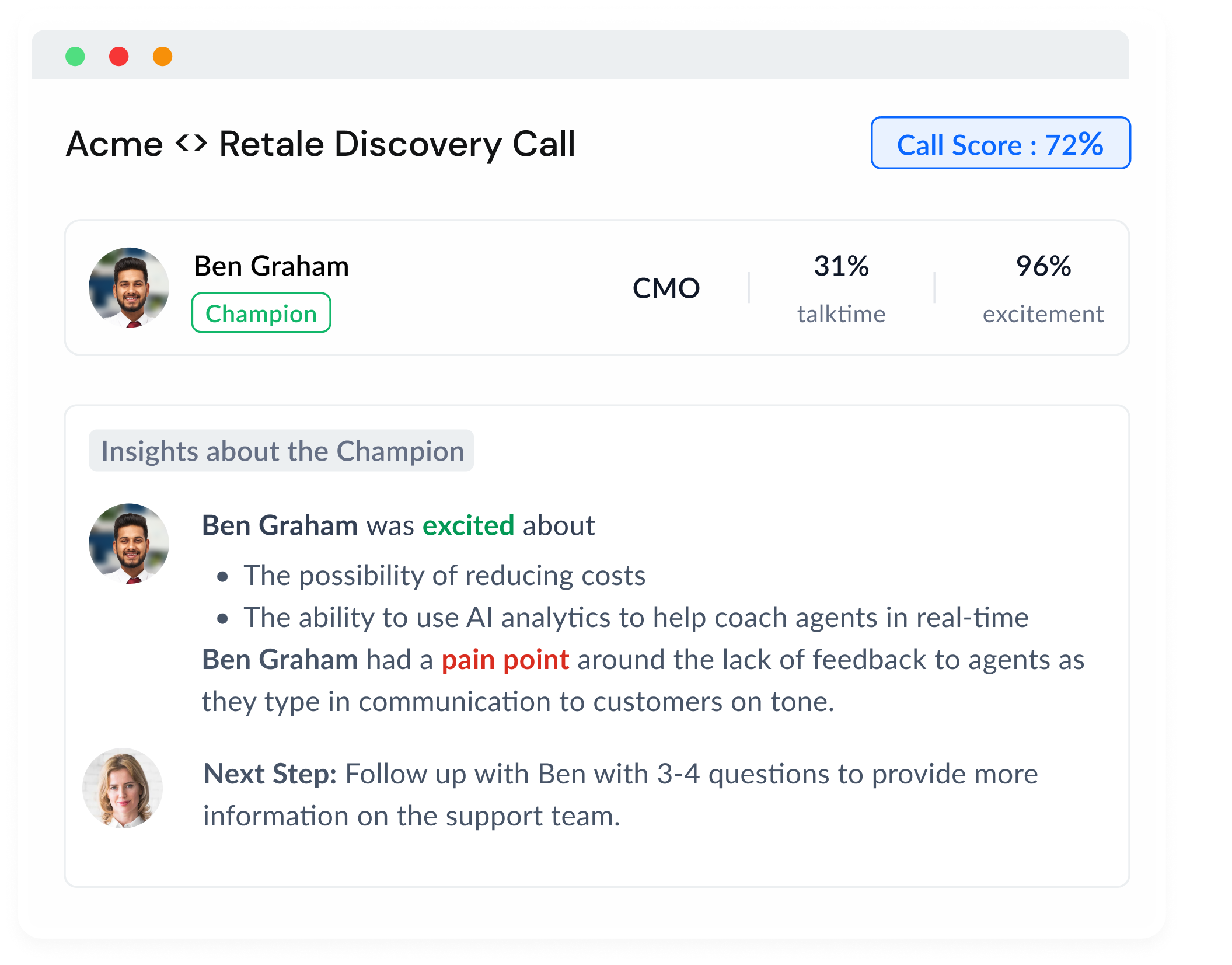Ah, the discovery call – the opening act of the sales play, where the characters are introduced, the plot is set, and the stage is lit. Just as a captivating first scene can make or break a theatrical performance, a well-structured discovery call can set the tone for a successful sales engagement.
In this blog, we'll guide you through the art of structuring the perfect discovery call. We'll explore the importance of these calls in the sales process, delve into the essential components of a successful conversation, and even reveal some tips and tricks to help you uncover the critical information you need to move the deal forward.
So, grab your script, step into the spotlight, and let's raise the curtain on the art of the discovery call.
The Importance of a Discovery Call
Before we dive into the structure, let's take a moment to appreciate the significance of a discovery call in the sales process. This call is the foundation upon which the entire relationship is built. It's where you gather valuable information about your prospect's needs, challenges, and goals. With this knowledge, you can tailor your sales approach, ensuring that your product's value proposition resonates with the prospect.
In essence, a successful discovery call is like a master key, unlocking the door to a fruitful relationship with your buyer.
The Anatomy of a Well-Structured Discovery Call
A discovery call, much like the human body, is composed of several essential elements. These components work together to create a cohesive, effective conversation that can propel the sales process forward.
- The Warm-up: Begin the call by setting a friendly, professional tone. Build rapport with the prospect by asking about their day, recent news, or other personal interests. This is akin to warming up before exercise – it gets the conversation muscles limber and ready for action.
- Context and Purpose: After the warm-up, transition to the main event by establishing the context and purpose of the call. Briefly explain what you hope to achieve and how the conversation will benefit the prospect. This sets the stage for a productive dialogue.
- Open-Ended Questions: The heart of the discovery call lies in asking open-ended questions that encourage the prospect to share their story. Inquire about their pain points, objectives, and current solutions. By actively listening, you gain insights that can inform your sales approach.
Here are some examples of open-ended questions you could ask during a discovery call to glean valuable insights about your prospects:
- What are the main challenges you're currently facing in your role or business? This question allows the prospect to share their pain points, giving you an understanding of how your product or service might solve those problems.
- Can you walk me through the process you currently use to handle [specific task or problem]? This will provide insight into their existing processes and help you position your solution more effectively.
- What are your key goals or objectives for this quarter/year? Knowing their goals helps you align your solution with their ambitions.
- What's the decision-making process like in your company for solutions like ours? This question can reveal who the key stakeholders are and what obstacles you may face in getting your solution adopted.
- What are some of the criteria you use to evaluate a solution like ours? This will help you understand what's most important to them when they consider a new product or service.
- How do you measure success in terms of [specific area relevant to your product/service]? Understanding their success metrics can guide you in tailoring your pitch and demonstrating how your solution can help them achieve success.
- What would be the ideal solution to your current challenges? This can uncover their expectations and help you highlight how your solution meets those needs. Remember, the goal of these open-ended questions is to engage the prospect in a meaningful dialogue, understand their needs and concerns, and gather insights to tailor your sales approach.
- Probing Deeper: Once you've gathered surface-level information, probe deeper to uncover the underlying motivations, constraints, and decision-making processes. These insights can prove invaluable in tailoring your pitch and overcoming objections later in the sales process.
- Sharing Value: As the conversation unfolds, look for opportunities to share relevant value propositions, case studies, or testimonials that address the prospect's specific needs and concerns. This helps to establish credibility and pique their interest in your product or service.
- Setting Next Steps: As your discovery call concludes, the path you've traversed together must lead to a new horizon. Here, setting next steps becomes the compass that aligns both you and your prospect toward a shared future.
Why Set Next Steps?
Setting clear next steps at the end of a discovery call is like planting a flag at the summit of your conversation. It gives both parties a clear view of the path ahead and creates a mutual commitment to continue the journey. It ensures that the momentum generated during the call doesn't dissipate but propels the sales process forward.
Types of Next Steps:
- Follow-up Call or Meeting: Perhaps the most common next step, scheduling another conversation, allows you to delve deeper into the issues discussed or present your product or service in more detail.
- Product Demo: If the prospect showed strong interest during the discovery call, it might be time to show them your solution in action. A demo is an excellent way to demonstrate how your product or service can meet their needs and overcome the challenges they've shared.
- Provide Additional Information: If the prospect requested more details or specific information, commit to sending it to them. This could be a white paper, a case study, technical specs, or any other relevant materials.
- Introduction to Other Team Members: Sometimes, the prospect may need to involve other decision-makers or team members. Offering to meet or present to these individuals can be a proactive next step.
Tips for Setting Next Steps
- Be Specific: Specificity is key when setting next steps. Provide clear details like the date, time, mode, and purpose of the follow-up or meeting.
- Gain Agreement: Ensure that your prospect agrees with the proposed next steps. It should feel like a natural progression rather than a forced obligation.
- Leverage Tools: Use the capabilities of tools like Asana or Notion to schedule follow-ups, set reminders, and prepare for the next steps. In addition, Sybill can provide you with insights from the discovery call, suggest follow-up actions, and even help you craft the perfect follow-up email.
In conclusion, setting next steps is a critical component of your discovery call. It's the bridge that connects the insights gained during the call to future conversations and potential conversions. So, as you wrap up your discovery calls, remember to chart the course forward, ensuring that your journey with the prospect continues toward a successful sale.
Tips and Tricks for an Effective Discovery Call
Now that we've dissected the anatomy of a well-structured discovery call, let's examine some tips and tricks to enhance your performance:
- Do Your Homework: Research the prospect's company, industry, and role to ensure that your questions and conversation are relevant and informed.
- Be Adaptable: While it's essential to have a structure in mind, remember to be flexible and adapt to the flow of the conversation.
- Active Listening: Show genuine interest and respect for the prospect's responses. Reflect back their thoughts to validate their concerns and ensure understanding.
- Take Notes: Document key points and insights for future reference.
Leveraging Sybill in Your Discovery Calls
In the adventurous expedition that is a discovery call, Sybill acts as your seasoned guide, ensuring you traverse the terrain effectively and hit all the necessary landmarks. Armed with the power of AI, it's an all-terrain vehicle equipped with tools that can make your journey easier and more fruitful.
Sybill, Your Trustworthy Co-pilot
Think of Sybill as your co-pilot, navigating you through the winding routes of a discovery call. With its post-call reporting on participant engagement and excitement on each section of the call, you can diagnose what worked and what didn't, and make improvements in future discovery calls.
Sybill the Scribe: Transcribing and Analyzing Calls
Sybill's capabilities go far beyond being a mere guiding hand. It meticulously transcribes each conversation, creating a written record that you can review and analyze. This is like having a cartographer draw out the map of your conversation, allowing you to revisit significant points and delve deeper into the nuances of your prospect's responses.
These transcriptions become a powerful tool for understanding your prospect's needs, pain points, and goals. They can serve as a treasure trove of information, revealing insights that can guide your sales approach and tailor your value proposition.
Crafting Insightful Summaries and Follow-ups
Once your discovery call comes to a close, Sybill transitions from navigator to town crier, compiling comprehensive summaries and crafting precise follow-up emails. This ensures that the crucial takeaways from your conversation are highlighted, and the dialogue continues even after the call.
This invaluable post-call assistance helps you keep track of the next steps and follow up effectively, ensuring that no opportunity is lost in the fray.
Guiding with Data-Driven Insights
One of Sybill's most potent arrows in its quiver is its ability to provide data-driven insights. By processing volumes of conversation data, it can identify patterns, trends, and insights that can help refine your discovery call strategies. This is like having an experienced trailblazer share their knowledge, empowering you to avoid pitfalls and follow the most promising paths.
With Sybill at your side, discovery calls become less about 'discovering' and more about 'knowing' – knowing your prospect, their needs, and the most effective approach to moving the sale forward. You will not just be discovering; you'll be understanding, learning, and strategizing. It’s your trusted ally, ensuring that each call uncovers a treasure trove of insights, propelling your sales process forward and setting the stage for successful engagements.
And there you have it! A comprehensive guide to structuring the perfect discovery call. Now, it's time to take center stage and deliver a performance that not only uncovers your prospect's needs but also sets the stage for a successful sales relationship. Break a leg!















.png)





